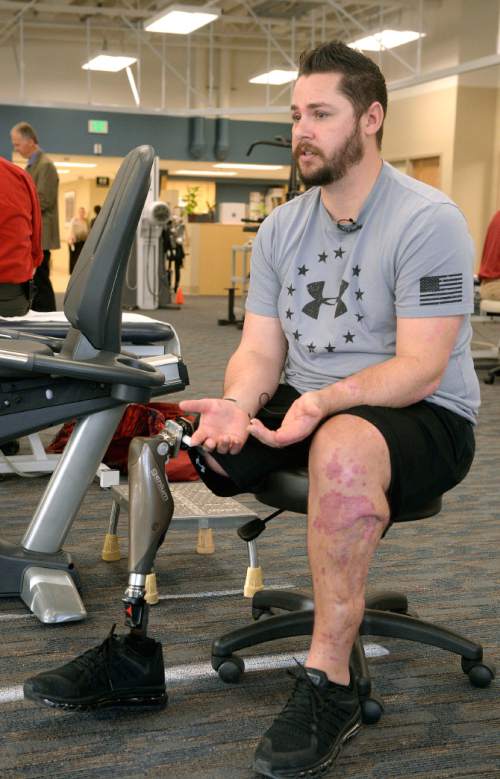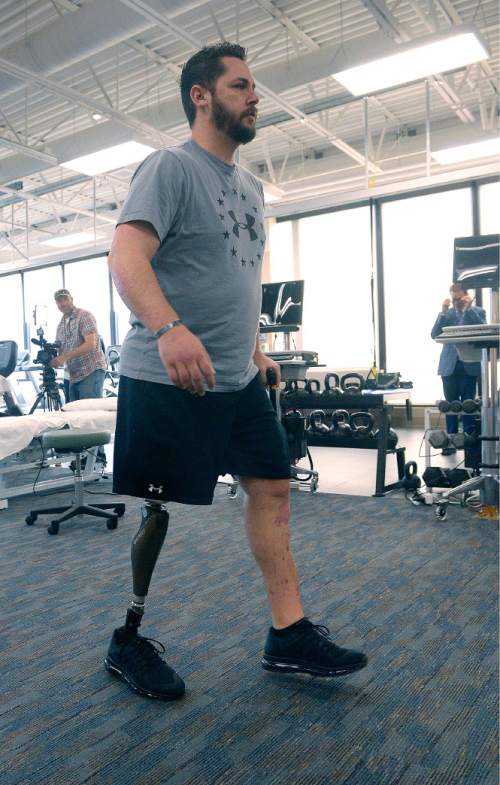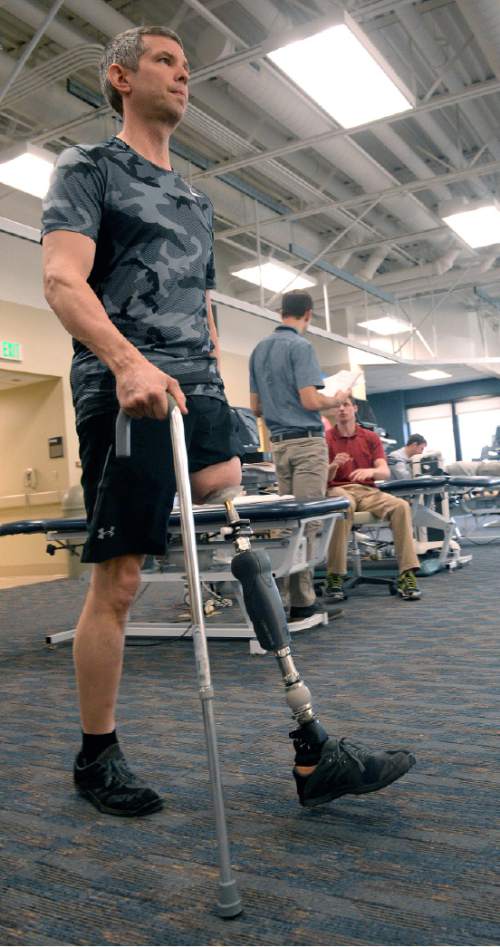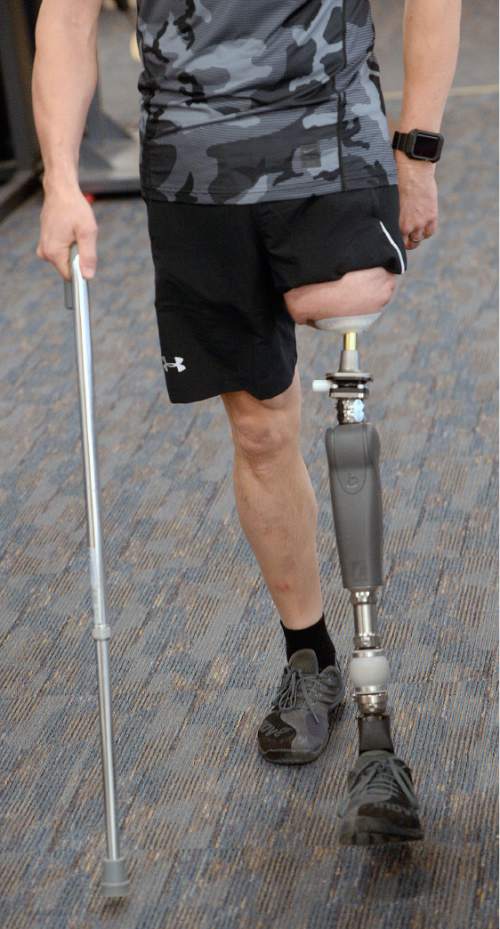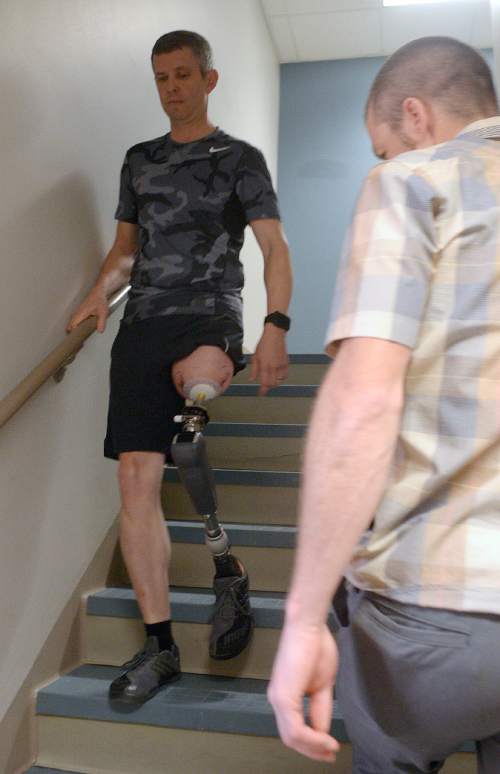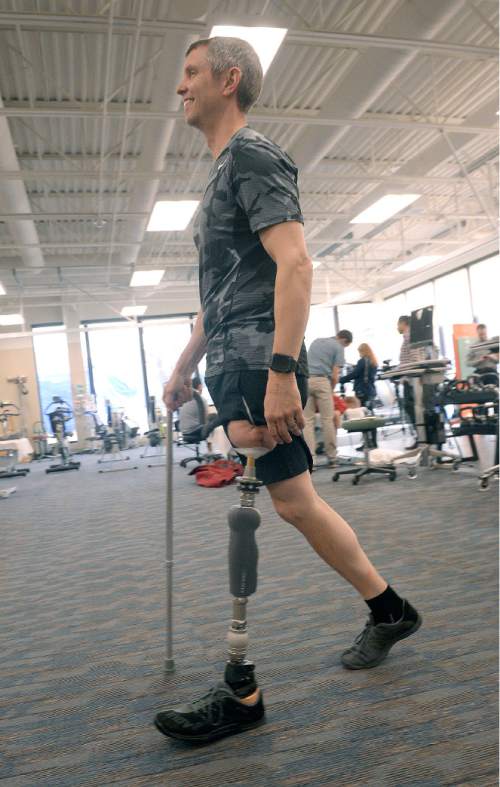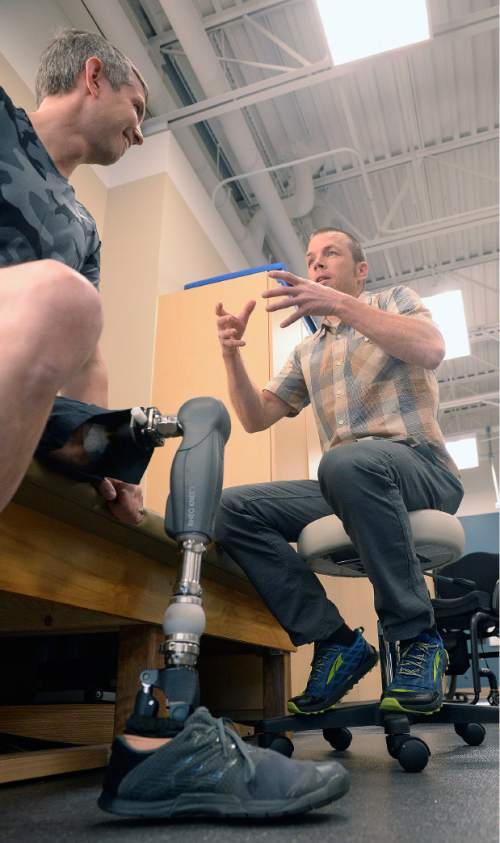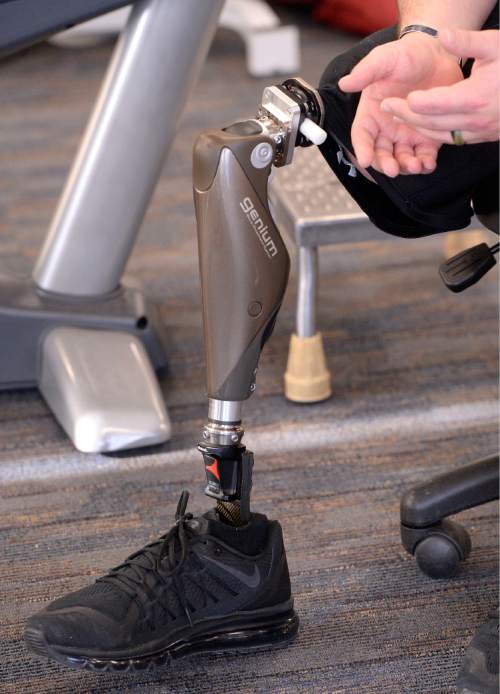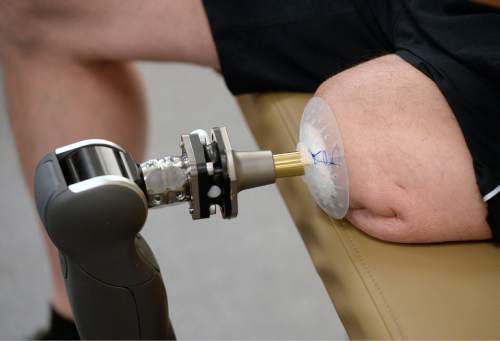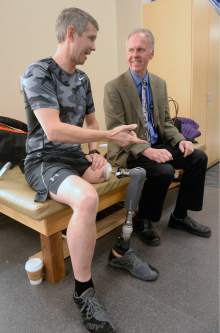Al Hartmann | The Salt Lake Tribune
VA patient Bryant Jacobs talks about his new prosthetic limb Wednesday Feb 24 in the physica
Al Hartmann | The Salt Lake Tribune
VA patient Ed Salau talks with Laurence Meyer, MD, PHD Assoc. Chief of Staff Research and De
Al Hartmann | The Salt Lake Tribune
VA patient Bryant Jacobs takes walking session on new prosthetic limb Wednesday Feb 24 in th
Al Hartmann | The Salt Lake Tribune
VA patient Ed Salau takes walking session on new prosthetic limb Wednesday Feb 24 in the phy
Al Hartmann | The Salt Lake Tribune
VA patient Ed Salau takes walking session on new prosthetic limb Wednesday Feb 24 in the phy
Al Hartmann | The Salt Lake Tribune
VA patient Ed Salau takes walking session on new prosthetic limb going down stairs Wednesday
Al Hartmann | The Salt Lake Tribune
VA patient Ed Salau takes walking session on new prosthetic limb Wednesday Feb 24 in the phy
Al Hartmann | The Salt Lake Tribune
VA patient Ed Salau, left, talks over his walking progress with VA physical therapist Bart G
Al Hartmann | The Salt Lake Tribune
VA patient Bryant Jacobs talks about his new prosthetic limb Wednesday Feb 24 in the physica
Al Hartmann | The Salt Lake Tribune
Detail of VA patient Ed Salau's new prosthetic limb after undergoing surgeries for a Percuta
Al Hartmann | The Salt Lake Tribune
VA patient Bryant Jacobs talks about his new prosthetic limb Wednesday Feb 24 in the physical therapy center at the Salt Lake Veterans Adminsitration Hospital. For the first time since undergoing surgeries for their Percutaneous Osseointegrated Prosthesis (POP) implant, he and fellow military veteran Ed Salau are walking on their residual limb as part of a Department of Veterans Affairs (VA) and FDA approved Early Feasibility Study (EFS) for above the knee amputees.
Al Hartmann | The Salt Lake Tribune
VA patient Ed Salau talks with Laurence Meyer, MD, PHD Assoc. Chief of Staff Research and Development during a break in a walking session on his new prosthetic limb Wednesday Feb 24 in the physical therapy center at the Salt Lake Veterans Adminsitration Hospital. For the first time since undergoing surgeries for their Percutaneous Osseointegrated Prosthesis (POP) implant, he and fellow military veteran Bryant Jacobs are walking on their residual limb as part of a Department of Veterans Affairs (VA) and FDA approved Early Feasibility Study (EFS) for above the knee amputees. After 17 days using the new device he said that he felt like a little kid learning to walk, but he sees steady improvement.
Al Hartmann | The Salt Lake Tribune
VA patient Bryant Jacobs takes walking session on new prosthetic limb Wednesday Feb 24 in the physical therapy center at the Salt Lake Veterans Adminsitration Hospital. For the first time since undergoing surgeries for their Percutaneous Osseointegrated Prosthesis (POP) implant, he and fellow military veteran Ed Salau are walking on their residual limb as part of a Department of Veterans Affairs (VA) and FDA approved Early Feasibility Study (EFS) for above the knee amputees.
Al Hartmann | The Salt Lake Tribune
VA patient Ed Salau takes walking session on new prosthetic limb Wednesday Feb 24 in the physical therapy center at the Salt Lake Veterans Adminsitration Hospital. For the first time since undergoing surgeries for their Percutaneous Osseointegrated Prosthesis (POP) implant, he and fellow military veteran Bryant Jacobs are walking on their residual limb as part of a Department of Veterans Affairs (VA) and FDA approved Early Feasibility Study (EFS) for above the knee amputees. After 17 days using the new device he said that he felt like a little kid learning to walk, but he sees steady improvement.
Al Hartmann | The Salt Lake Tribune
VA patient Ed Salau takes walking session on new prosthetic limb Wednesday Feb 24 in the physical therapy center at the Salt Lake Veterans Adminsitration Hospital. For the first time since undergoing surgeries for their Percutaneous Osseointegrated Prosthesis (POP) implant, he and fellow military veteran Bryant Jacobs are walking on their residual limb as part of a Department of Veterans Affairs (VA) and FDA approved Early Feasibility Study (EFS) for above the knee amputees. After 17 days using the new device he said that he felt like a little kid learning to walk, but he sees steady improvement.
Al Hartmann | The Salt Lake Tribune
VA patient Ed Salau takes walking session on new prosthetic limb going down stairs Wednesday Feb 24 at the Salt Lake Veterans Adminsitration Hospital. For the first time since undergoing surgeries for their Percutaneous Osseointegrated Prosthesis (POP) implant, he and fellow military veteran Bryant Jacobs are walking on their residual limb as part of a Department of Veterans Affairs (VA) and FDA approved Early Feasibility Study (EFS) for above the knee amputees. After 17 days using the new device he said that he felt like a little kid learning to walk, but he is sees steady improvement. Stairs are a challenge and he's supervised by VA physical therapist Bart Gillespie, right.
Al Hartmann | The Salt Lake Tribune
VA patient Ed Salau takes walking session on new prosthetic limb Wednesday Feb 24 in the physical therapy center at the Salt Lake Veterans Adminsitration Hospital. For the first time since undergoing surgeries for their Percutaneous Osseointegrated Prosthesis (POP) implant, he and fellow military veteran Bryant Jacobs are walking on their residual limb as part of a Department of Veterans Affairs (VA) and FDA approved Early Feasibility Study (EFS) for above the knee amputees. After 17 days using the new device he said that he felt like a little kid learning to walk, but he sees steady improvement.
Al Hartmann | The Salt Lake Tribune
VA patient Ed Salau, left, talks over his walking progress with VA physical therapist Bart Gillespie, right, Wednesday Feb 24 at the Salt Lake Veterans Adminsitration Hospital. For the first time since undergoing surgeries for their Percutaneous Osseointegrated Prosthesis (POP) implant, he and fellow military veteran Bryant Jacobs are walking on their residual limb as part of a Department of Veterans Affairs (VA) and FDA approved Early Feasibility Study (EFS) for above the knee amputees. After 17 days using the new device he said that he felt like a little kid learning to walk, but he sees steady improvement.
Al Hartmann | The Salt Lake Tribune
VA patient Bryant Jacobs talks about his new prosthetic limb Wednesday Feb 24 in the physical therapy center at the Salt Lake Veterans Adminsitration Hospital. For the first time since undergoing surgeries for their Percutaneous Osseointegrated Prosthesis (POP) implant, he and fellow military veteran Ed Salau are walking on their residual limb as part of a Department of Veterans Affairs (VA) and FDA approved Early Feasibility Study (EFS) for above the knee amputees.
Al Hartmann | The Salt Lake Tribune
Detail of VA patient Ed Salau's new prosthetic limb after undergoing surgeries for a Percutaneous Osseointegrated Prosthesis (POP) implantat at the Salt Lake Veterans Adminsitration Hospital. Salau and fellow military veteran Bryant Jacobs are walking on their residual limb as part of a Department of Veterans Affairs (VA) and FDA approved Early Feasibility Study (EFS) for above the knee amputees.


